Search results
17 results found.
17 results found.
That sound you may have thought was silence from out here was actually the sound of me putting my shoulder to the titanic wheel, so to speak, of the registration work for the annual event known as the Vogalonga, or “long row.”
This year it will be held on this coming Sunday, June 12. It has never been held this late in the year (May has been its preferred month), and I’ll explain the reason for this in a moment.
Just like people, each of these oar-driven marathons for the past 36 years is different, yet each one is the same. Thousands of rowers in all sorts of boats proceeding around a 30-km (18-mile) course betwixt the islands of the northern lagoon.
Every year there are more of them rowing in single kayaks, and far too many of them get in the way and do things that do not demonstrate a profound experience either of boats and a tidal lagoon, by which I mean they don’t seem to realize there is a tide working harder than even they are — against them, with them, or a blend of both. Their not taking the tide into account conduces to many little surprises for them. Any nearby Venetians, knowing this, have already come up with Plan B to avoid getting involved in their assorted miscalculations.
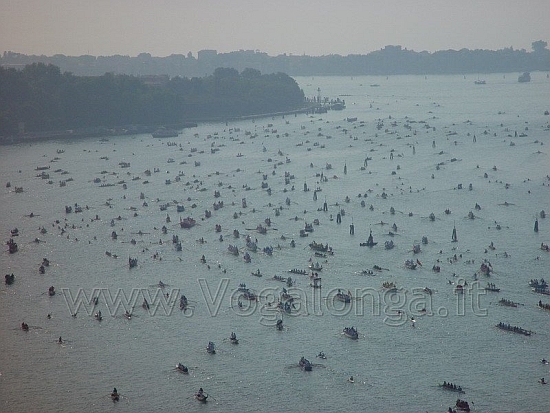
Back to the registration work: It goes on for two weeks, and today and tomorrow, being the last days (and being the weekend) will be spectacularly chaotic at the office, as thousands of just-arrived, already-happy-and-excited rowers appear to claim their pectoral with the registration number, and the T-shirts allotted to them. There is often much debate among them about what size Ingrid or Francois is going to need, while masses of waiting rowers pile up behind them.
In the early days — last week — I’d take a Medium (or whatever) out of its plastic bag to demonstrate what it looked like (leading to more debate…..). But those days are gone. If somebody asks me now for two Large, I just give them to him/her. If they want to exchange them they have to go to the back of the line and wait their turn. It’s either me doing that, or fifty impatient rowers deciding to take matters into their own hands.
Briefly, the reason why we will be rowing for hours in mid-June (which translates as “probably scorchingly hot”) is because this year it’s Venice’s turn to host an annual event which rotates among the four participating cities of Venice, Pisa, Florence, and Genoa.
It’s called the Palio of the Four Ancient Maritime Republics, and it’s rowed on eight-oar boats, something like life-saving boats, called “galleons.” In case you’re wondering what Pisa is doing in the lineup, Pisa was an important port city before the harbor silted up and they built that tower and batches of city on top of it. They’ve been digging up sunken Roman ships in town for years now.
Fine, I hear you say, but how does this concern the Vogalonga? Because the organizing committee of the Palio thought it would be cool to hold their race on the afternoon of the Vogalonga, seeing as there would already be so many boats in the water (us). The rowers could just stay in the water and watch the race and provide a lot of nautical garnish to the spectacle.
I will have to let you know how that fantasy works out, because from my own experience, I can say that the last thing anybody feels like doing at the end of possibly five hours in a boat is to stay in the boat, even to watch the World Cup. Your primary thoughts at the end are for food, shade, a shower, and a chaise longue, if not a bed in a room with the blinds pulled down.
You have no secondary thoughts. If you did, I’m pretty sure they wouldn’t be to stay in or near the water and watch a race that starts at 6:00 PM.
But what, as I often ask myself, do I know? I’ll let you know how it all turns out.
Back to the registration work. There are two questions many people can’t resist asking when they sign up. One is “How many boats are there?” I don’t know and I don’t really try to know. I’m just slinging T-shirts. And besides, does it matter? Have they organized an office pool on who bets closest to the correct number? They’re here, so whether there are 2,893 or 5,001 boats can’t make any real difference. Perhaps I’m wrong.
Second baffling question: “What’s the weather going to be?” If any forecast, even for six hours from now, turned out to be correct, it would be amazing. Instead of replying, “You believe forecasts?” I have always tended to say, “All I can tell you is that whatever the weather is for you, it’s going to be the same for everybody else.”
This year I’m trying something different. When they ask me, I just say “Beautiful. It’s going to be beautiful.” I’ll either be right or wrong, just like any other forecaster.
I experienced an amusing variation this year: I brought the Vogalonga cell phone home last night and left it on while I recharged it. Two calls came in at 11:40 PM. I was sound asleep.
I didn’t even answer them, I just turned the phone off and tried to get back to reclaim that dream they so rudely interrupted.
Checking the numbers this morning, I see that one call was from an area near Rome, the other from Munich. When I got up at 5:00, I was extremely tempted to call them back. But the satisfaction would only have been momentary, so I let it go.
I may not be helpfully demonstrating T-shirt sizes anymore, but at least I haven’t descended to the level of vendetta.
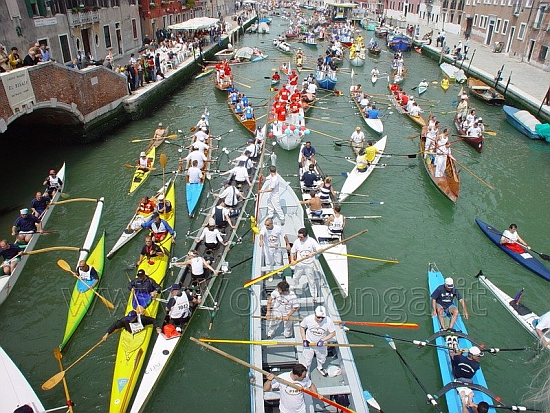
It all seems (in fact, it all is) very long ago now, but last May 23 was the 36th edition of the annual rowing marathon called the Vogalonga.
The 2009 edition was fairly appalling, and if I were to feel like writing a full account I’d need a strip of paper five Babylonian cubits long, or whatever the electronic equivalent might be.
This year everything was perfect, so I didn’t have anything to write about. You know how they say bad news is more interesting than good news? (I guess somebody says that.) Same thing here. How many different ways can you say “It was great”?
But great or ghastly as the “Long Row” may be, each year the organizing committee gives each rower a numbered stub when he or she registers, then a few months later puts on a raffle and holds a drawing for the prizes.
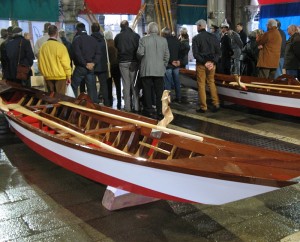
I dimly recall this event as occurring closer to the date of the Vogalonga itself, but for the past several years this convocation has been scheduled for late fall, when one’s memories of the equatorial heat and humidity, or whatever other weather dominated your spring morning in the lagoon, have been replaced by the sepulchral chill of an autumn twilight.
Thus we gathered last Friday night, in the waterside pavilion of the fish market at the Rialto, as usual, for the official thanking-of-many-brave-and-tireless collaborators, and for the drawing.
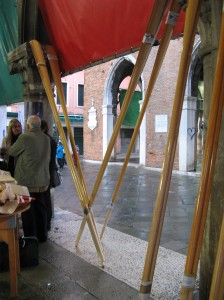
The prizes are pretty simple: Nine pairs of forcolas and nine pairs of oars, either pair suitable for rowing a Venetian mascareta. And two gleaming, brand-new mascaretas in the flesh.
One was financed by the Casino, a bittersweet reminder of the days not so long ago when the Casino had money to lavish on sponsorships all over the city, before their guy in the green eyeshade hit “total” and discovered they were 45 million euros ($52,356,493) in the red. And the other vessel was offered by the Assessorato al Turismo, or Tourism Department, similarly reduced, or so the reports have it, to eating shoe leather and tree bark to stay alive. I remember when there were three boats to be raffled off, but times are hard even in mascaretaland.
Here is how the event feels: I smile at an assortment of boating friends, (good); I feel the cold and damp seeping from the wet granite paving stones up through my shoes as the darkening air forms moisture everywhere around me (less good, but tolerable). And I metaphorically clamp an inverted facelock around the head of that inevitable craving that always lunges at me from when I see a boat that might, perhaps, in my dreams, be mine — that Christmas-morning suspense, but without any of the pleasure of knowing you’ll actually get to open the presents (not good at all.)
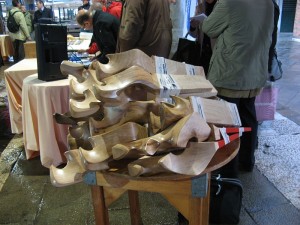
So we walked around the boats, like everybody else was doing. We stood and listened to the various pronouncements made by Lalo Rosa Salva, chief organizer and tutelary deity of the Vogalonga. We watched the winners walking away with their prizes. I stifled my urge to wail.
And then there was the buffet. No event can ever be said to have occurred in life here if food is not in some way attached to it. Attached at the end of said event, naturally, otherwise people would just skip it and head directly to the noshfest, however modest it might be.
Because the Rosa Salva family runs one of the city’s oldest and best-known pastry-making and catering operations, there were sandwiches and cookies and wine and sodas and water galore.
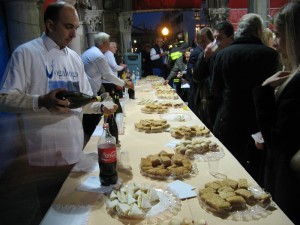
I remember when the buffet was somewhat more sumptuous — not that I’m complaining. But let the record show that I remember a generous assortment of sandwiches, and tiny finger-pizzas, and pastries as well as cookies, and also fruit. Those were buffets that had a certain allure, as attested by the variety of matrons who, in their instinctive, ruthless way, would appear from nowhere and always get to the table first, claiming their spot with more conviction than Columbus claiming North America, and not budging.
They’d stand there eating, elbows half-cocked to ward off any possible intruders, and I have even seen these dowagers stuff extra snacks into their conveniently large handbags. Or even shopping bags, brought for the occasion. Yes, I have seen that with these very eyes. The buffet has always, at least up to the other night, provided more drama than the drawing, because some ignorant or foolhardy person would occasionally try to displace one of these dreadnoughts. This year, though, the dowagers didn’t even show up. A sign more vivid than the shrinking prizes that times have indeed become hard. Pretty soon we’ll have to start stockpiling canned goods.
Oh, about the boats: I didn’t win one. But as I watched members of the two lucky clubs carry the mascaretas bodily to the Grand Canal, some perplexing thoughts seeped into my mind.
Such as: If Venetian rowers (by which I mean people, of whatever provenance, who row in the Venetian way) form the smallest possible percentage of participants, which they do (something like a quarter of the total) why are the prizes only suitable for Venetian rowing? Me, I think it’s just fine, and a brilliant way to stand firm for whatever can still be maintained of Venetian-ness. I merely note that for someone from Lithuania who rows a kayak, a forcola and an 11-foot [3.30 meters] wooden oar might not be exactly what they’d consider a prize. Of course they could sell it, but that would be crass.
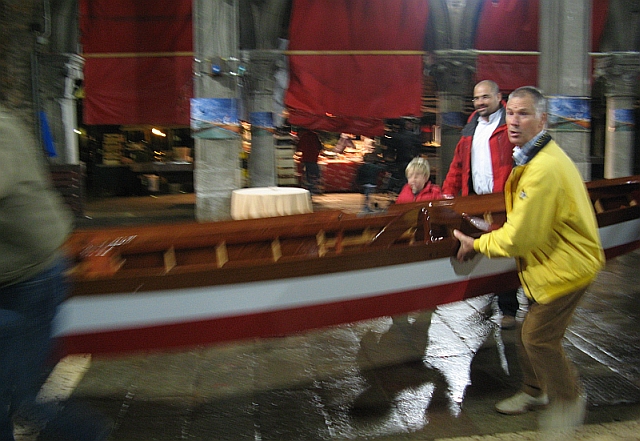
And this: Why would either of the entities who paid for the two boats feel any particular need or desire to do so? Of course it’s a very handsome gesture, but if the main purpose is self-publicity — and I may have misinterpreted the reasoning — there must be items with more advertising throw-weight than two little boats which will only ever be seen here where everybody already knows about the Casino and the Tourism Department.
And this: I know raffles are intended to be, or to appear to be, composed of free gifts (i.e., gifts paid for by somebody other than the participants). But considering that each person pays a registration fee, technically you could say that the winner of oars or forcolas had already paid for them. But there I go, being crass.
Anyway, I didn’t win anything, so I don’t care. Now I think I’ll go buy a lottery ticket. Maybe my odds will improve and then I’ll be able to buy an entire boatyard all for myself.
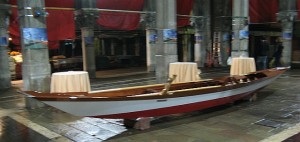
Every year since 1975, the organizing committee picks a Sunday in spring and announces the date of the next edition of the Vogalonga, or “long row.” When we heard it was going to be May 31 this year, the first thing most of us thought was “Saharan sun-scorch.” None of us thought “Arctic gale winds,” at least not until we looked out the window that morning.
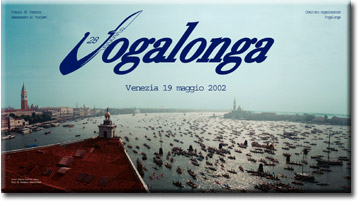
What it is:
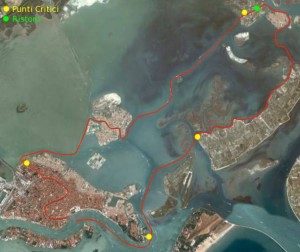
What it isn’t:
The reason it makes no sense to promote this event as a protest is because:
One other thing: I’ve experienced a few protests over time, events involving mounted policemen and tear gas and so on. I don’t remember there being people laughing and waving to their friends and taking each other’s pictures and drinking beer. Call it whatever you like; the Vogalonga is essentially one big party, and two large objects like parties and protests just can’t occupy the same space. So much for the protest theory.
We were there this year rowing “San Marco,” the club’s 8-oar gondola. And I’m pretty sure that like everyone else out there when the starting cannon fired at 9:00 AM, we were all thinking, in our various ways, “ohgodohgodohgod.”
Lino admitted when it was all over that he’d had the tiniest hint of a second thought as we started out, but he’s done all 34 and he was determined to make it through the 35th. There aren’t many left who can make that claim, and he was going to do it unless, you know, sheer survival were to become an issue. Not too bad, when you consider that within the space of five months, he’s had a new hip and a pacemaker installed. And that two of the boys aboard had rowed only twice. Ever.
A tremendous wind was blowing, the implacable northeastern blast called the bora, and there were gusts up to 50 miles an hour. Also, the tide was going out, which meant that naturally everyone had to row against it, too. Wind and tide. And it was cold. I’m telling you.
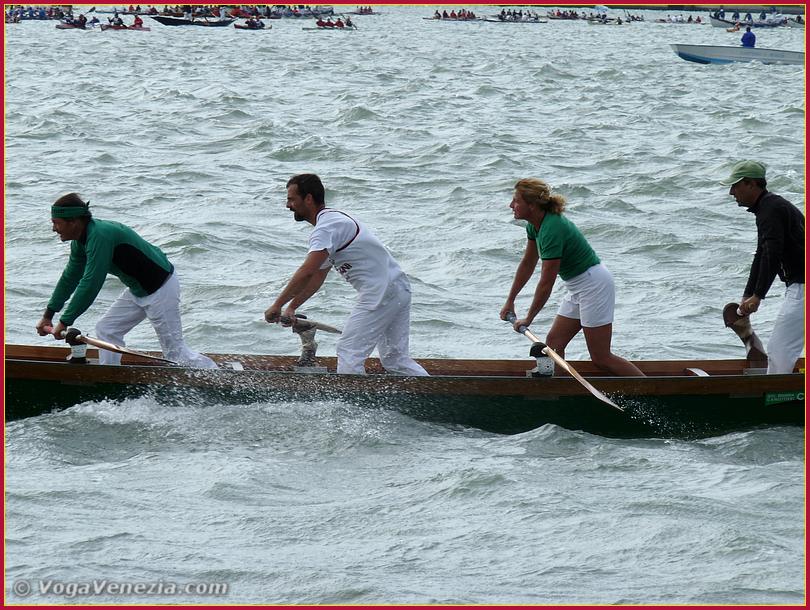
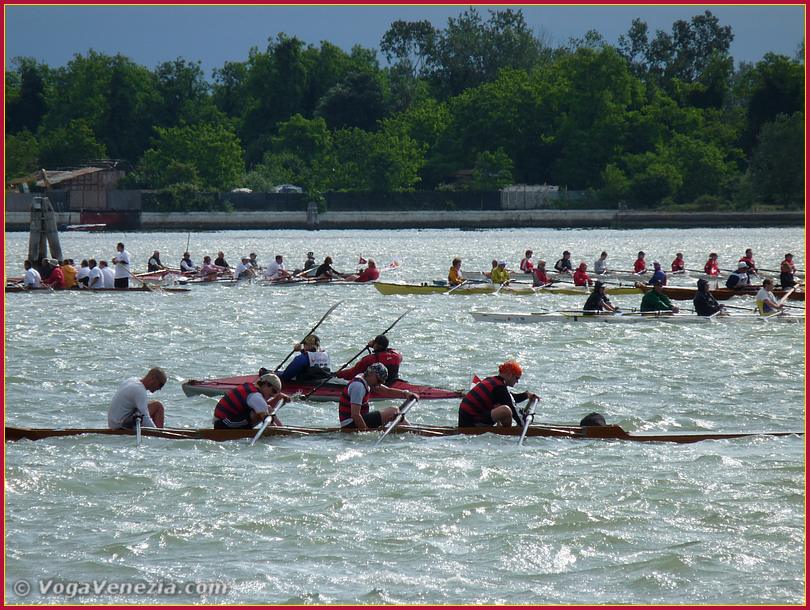
It took us seven hours to finish what normally would have taken four (well, five), but at least we didn’t run into anybody or anything, like channel-marker pilings, though we came close a few times, and we didn’t capsize, which is more than some 30 other boats could claim. The assistance teams stationed around the course had to call for reinforcements to pull people and assorted hulls and oars out of the water.
But we did it, due mainly to Lino, not only because of his strength but even more because of his experience and savvy (“You don’t row with your arms,” he says, “you row with your brain.” The proof of this was seeing the consequences to rowers who didn’t think of how to find some way to make their life out there at least slightly easier, looking for positions that would be more sheltered from the wind, or where the tide would be less strong).
But even with his experience and grit, we, like everybody else out there, had to put everything into it. The wind just never let up, though occasionally it would hurl itself against the right side of the boat, which would slew to the right, so I had to exert a sudden powerful counterstroke to keep the boat from slewing around to the right, usually in front of an onrushing cavalcade of hapless rowers. Lino, astern, exerted his own counterstroke whenever the wind shifted to the left side of the boat. the same when the wind shifted. The others just kept rowing along, like the slaves below decks in Ben-Hur.
But we all had confidence in him, which was the real secret to it all. I can say that because another boat from our club turned back. It wasn’t that they couldn’t do it physically; they had no confidence. Mental, not muscles. I want you to remember that — it’s another of those crucial Life Lessons you pick up in a boat. I have quite a list by now.
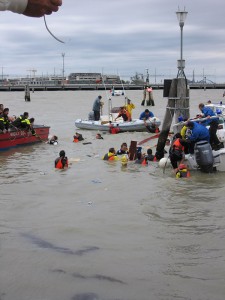
About those capsized boats. Some accounts make it sound as if the entire course was like the Spanish Armada being blown around England. In fact, the accidents were pretty much limited to a particular category in a particular location:
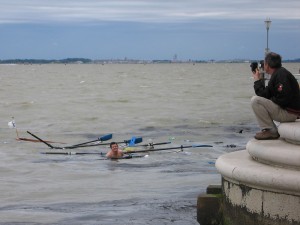
Knowledgeable, or cautious, rowers tended to swing wide before positioning themselves for entry into the canal, thereby avoiding the worst.
I’m explaining all this because you never know when it might be useful to know this.
I took several aspirin and was in bed before 9:00 that night. My last thought was wondering which parts of my body were going to hurt the most the next morning.
Surprisingly, very few. Almost none, really, except for a lovely pair of screaming matched trapezius muscles. And my hands, which felt like lobster claws. Gripping an oar, exerting about a thousand pounds-force per square inch on a stick of wood for much of seven hours, has quite an effect on the old mitts. All those years of piano lessons? No more hope of Rachmaninoff for me.
What really astonishes me is my capacity to remember events like this with something like pleasure. Must be hormones or something, the euphoria of survival. The traps have stopped crying, the hands are back at the keyboard, and I’d say I’m almost ready to do it all again. Like so many things in Erlaworld, it makes no sense.
(Below: In the Cannaregio Canal. We’re smiling because the end is in sight, and because finally we’re going with the tide. I’m the waver wearing the red baseball cap. I have no recollection who I’m waving at.)
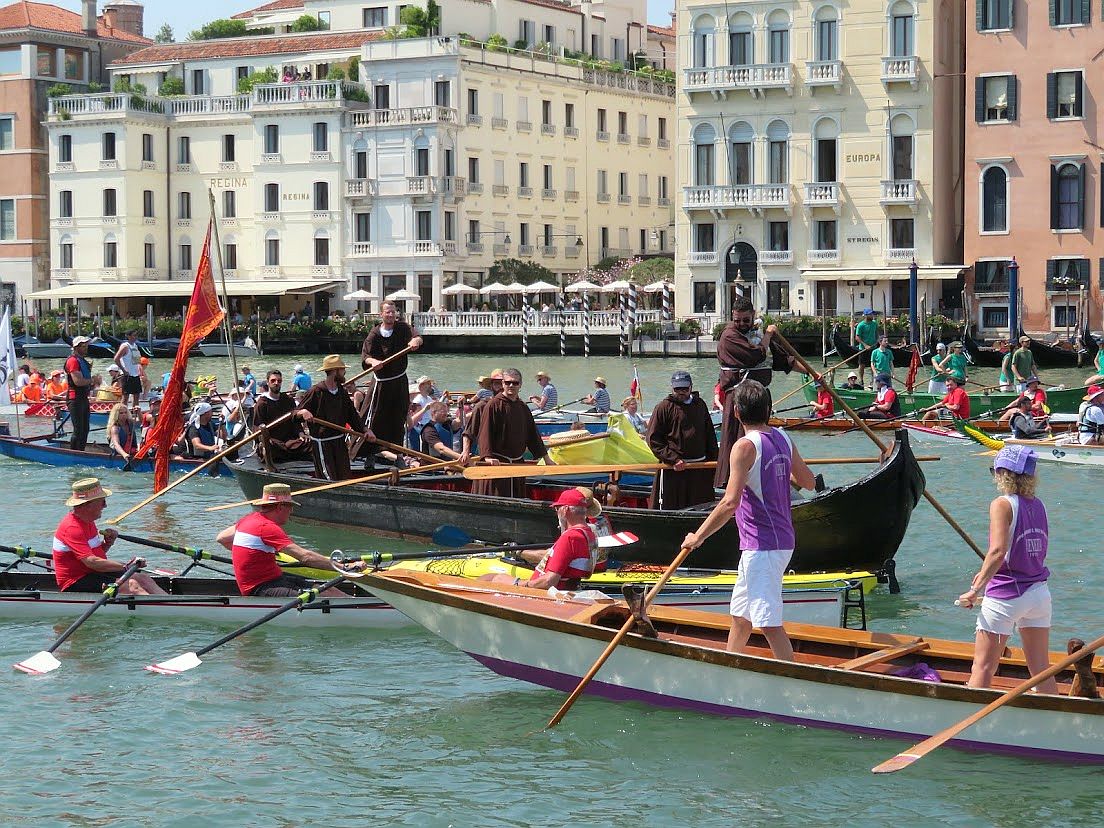
More advice on protecting yourself from pickpockets (other than staying at home, under the bed).
Where else is your wallet at risk? At the automated vaporetto-ticket machines. By the time you’ve finished deciphering and following the instructions, your worldly goods may well have moved on. If not yet, the pickpockets have seen where you put your wallet. Getting through the turnstiles is sufficiently distracting that you won’t notice that they are right behind you as you pass through.
“In very crowded areas,” my friend explained, “they get so close to you, you don’t even know they’ve opened your bag.”
Another thing: “Crossing crowded bridges is another way to get your bag opened up,” etc. etc. etc.
I have no doubt that all this information and advice is valid also in Florence, Rome, Milan, and any other city that attracts lots of people. They don’t have to all be tourists, there just have to be lots of them and the thieves have their cover.
Tour guides have been stolen from — one German guide was pickpocketed inside the basilica of San Marco. The spouses of tour guides have been ditto ditto. On especially busy days (for example, from now till October) there are hundreds of these incidents a day.
Don’t bother pining for the good old days under the doge and the Council of Ten. As Lino occasionally remarks, “They used to cut the thief’s hand off. He kept stealing anyway.”